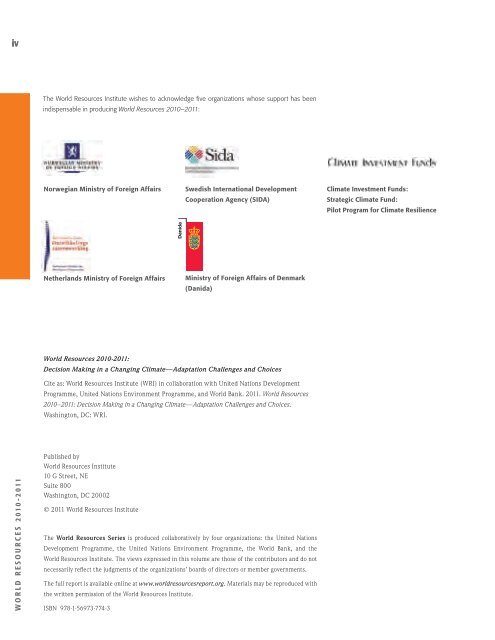Decision Making in a Changing Climate - World Resources Institute
Decision Making in a Changing Climate - World Resources Institute
Decision Making in a Changing Climate - World Resources Institute
- No tags were found...
Create successful ePaper yourself
Turn your PDF publications into a flip-book with our unique Google optimized e-Paper software.
Bear density appeared to be higher on the NSA (17.0/100km 2 ) than theSSA (9.4/100km 2 ), but the sex-age composition was very similar for the 2 studyareas. Adult females constituted approximately 30% of study populations andadult males accounted for 15-19%. Annually, relative proportions of yearl<strong>in</strong>gsand subadult males appeared to vary the most.Us<strong>in</strong>g the habitat model, we predicted suitable black bear habitat acrossapproximately 58,939 km 2 (14.6 million acres), of which 75% was comprised ofprimary cover types. Nearly 50% of the predicted suitable bear habitat wasmanaged by the U. S. Forest Service, 33% was under private ownership, andtribal lands comprised about 10% of the area. Statewide, 17% of predicted bearhabitat was with<strong>in</strong> 5 km of human-populated areas. Although currently based onrelatively coarse data, the model was constructed so that future, more resolved<strong>in</strong>formation can be easily <strong>in</strong>corporated to update model predictions.Extrapolat<strong>in</strong>g observed density estimates to areas of primary habitatyielded a statewide population estimate of 5,947 bears 1 year old. Thisestimate was similar to the <strong>in</strong>dependent estimate of 5,200 derived frompopulation model<strong>in</strong>g for the state (exclud<strong>in</strong>g the Zuni, Mt. Taylor,Sandia/Manzano, and Chuska regions). These estimates refute the previousestimate of 3,000 bears used by the NMDGF, however they do not suggest adoubl<strong>in</strong>g of the bear population <strong>in</strong> the past decade. Rather, these estimates arebased on better <strong>in</strong>formation and, as such, are more reliable.Analyses of harvest data from 1985-1999 <strong>in</strong>dicated bear hunters <strong>in</strong> NewMexico consistently harvested more males than females. The female proportionof annual statewide harvest ranged from 29 to 46%. Total annual bear kill byhunters was affected by many factors <strong>in</strong>clud<strong>in</strong>g season tim<strong>in</strong>g, hunter effort,hunter method, and mast production, as well as underly<strong>in</strong>g populationcomposition. Hunters aided with dogs had higher success rates and harvested 4times as many female bears per hunter as those not us<strong>in</strong>g dogs. Later fallseasons were associated with lower total harvest and lower proportions offemales <strong>in</strong> the harvest, compared to earlier fall seasons and spr<strong>in</strong>g seasons.Failures <strong>in</strong> oak production were associated with <strong>in</strong>creases <strong>in</strong> hunter effort, huntersuccess, and the proportion of females <strong>in</strong> the kill.Accuracy and consistency of the cementum annuli ag<strong>in</strong>g techniqueappeared adequate for assess<strong>in</strong>g the age composition of annual hunter-killedbears and report<strong>in</strong>g of sex appeared to be accurate. However, analyses<strong>in</strong>dicated harvest data were <strong>in</strong>complete, underestimat<strong>in</strong>g the annual bear kill byas much as 7%.The bear population model was designed to simulate a black bearpopulation through time, with biological realism, hunt<strong>in</strong>g, and environmental<strong>in</strong>fluences. Us<strong>in</strong>g observed reproductive and survival rates, model<strong>in</strong>g <strong>in</strong>dicatedstudy populations were either stable or slightly <strong>in</strong>creas<strong>in</strong>g. Future utility of theBlack Bear Study <strong>in</strong> New Mexico v F<strong>in</strong>al Report - 2001
















